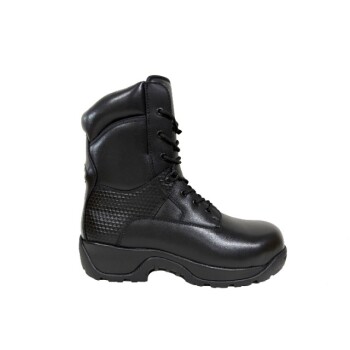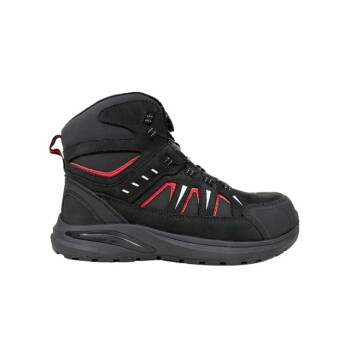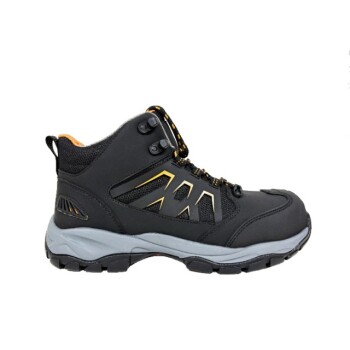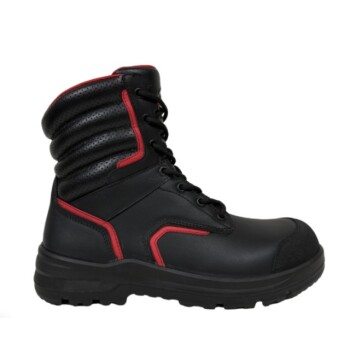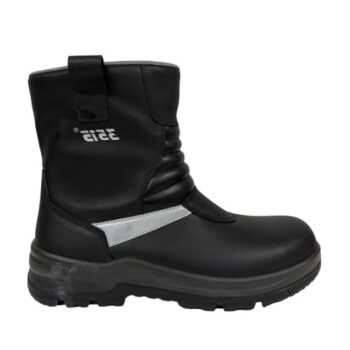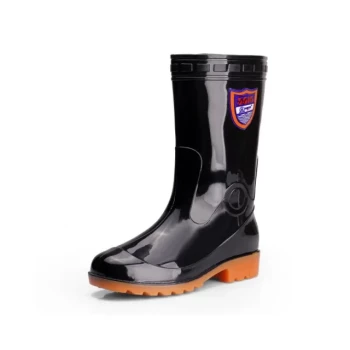The raised, logger-style heel on many wildland fire boots is a specialized design feature for stability. This high heel acts as an anchor, allowing firefighters to dig into steep or uneven terrain for a more secure footing, which is critical when working on treacherous inclines.
The choice of heel height in a wildland fire boot is a direct trade-off between stability and mobility. A high "logger" heel excels at providing grip on steep slopes, while a lower "hiker" heel is optimized for comfort over long distances on flatter ground.

The Role of the Heel in Wildland Firefighting
The design of a fire boot's heel is not arbitrary; it's a functional choice directly related to the wearer's primary tasks and the environment they work in.
The "Logger" Heel for Stability
The prominent, raised heel characteristic of the "logger" style is engineered for grip.
When a firefighter is traversing a steep hillside, this heel allows them to firmly plant their foot, preventing dangerous slips and providing a stable base of support for physically demanding work like cutting firelines.
The "Hiker" Heel for Mobility
Contrary to a common assumption, not all wildland boots have high heels. Many modern designs feature a lower-profile heel, similar to a traditional hiking boot.
This "hiker" style is better suited for firefighters who cover long distances over more moderate terrain. The design reduces fatigue and offers an ergonomic advantage for walking and patrolling.
Beyond the Heel: Core Safety Requirements
While the heel is important for performance, every wildland boot must meet strict safety standards mandated by the National Fire Protection Association (NFPA) to protect against the extreme environment.
Melt-Resistant Soles
Wildland firefighters work in environments with extreme ground heat. Their boots must have a melt-resistant Vibram-type rubber lug sole.
This specialized sole provides essential traction and is engineered to withstand high temperatures without softening, melting, or becoming damaged.
Heat-Resistant Uppers
The entire exterior of the boot must be made of durable leather.
Unlike synthetic materials that can liquify and cause severe burns when exposed to high heat, leather maintains its structural integrity, offering a critical layer of protection.
Indestructible Stitching
The threads holding the boot together are just as important as the leather.
Boots use fire-resistant stitching, often made from self-extinguishing fibers like Technora. This ensures the seams remain intact under heat stress and don't unravel, which would compromise the entire boot's safety and structure.
Understanding the Trade-offs: Logger vs. Hiker
Choosing between the two primary styles of wildland boots involves weighing their distinct advantages and disadvantages based on the expected work environment.
Logger Style: Maximum Stability
The primary benefit of the logger heel is its unmatched grip on steep ground.
However, this design can be heavier and less comfortable for extensive walking, especially on flat or hard-packed surfaces.
Hiker Style: Optimized for Endurance
The hiker style prioritizes comfort and flexibility, making it ideal for firefighters who need to be mobile and cover many miles a day.
While providing excellent traction, its lower-profile heel offers less "dig-in" capability on the steepest and loosest of slopes compared to the logger style.
The Importance of a Proper Break-In
Regardless of the style, a quality wildland boot requires a break-in period.
This process allows the durable footbed to mold perfectly to the wearer's foot, ensuring the optimal support and comfort needed to endure a full fire season in harsh conditions.
Making the Right Choice for Your Role
Selecting the correct boot is a critical decision that impacts both safety and effectiveness on the fireline. Your specific role and the terrain you face should guide your choice.
- If your primary focus is cutting firelines on steep hills: The superior stability of a logger-style heel is essential for safety and performance.
- If your primary focus is mobility over long distances on varied terrain: A hiker-style boot will provide greater comfort and reduce fatigue throughout the day.
- If you are new to the field: Always consult with experienced crew members to understand the typical terrain you will encounter before purchasing your boots.
Choosing the right boot is about selecting the proper tool for the job, ensuring you can perform your duties safely and effectively.
Summary Table:
| Feature | Logger Heel | Hiker Heel |
|---|---|---|
| Primary Benefit | Maximum stability on steep slopes | Optimized comfort for long-distance walking |
| Best For | Cutting firelines on treacherous, uneven terrain | Patrolling and covering long miles on varied ground |
| Trade-off | Can be heavier, less comfortable on flat surfaces | Less "dig-in" capability on the steepest slopes |
Need High-Performance Wildland Fire Boots for Your Team?
As a large-scale manufacturer, 3515 produces a comprehensive range of NFPA-compliant footwear for distributors, brand owners, and bulk clients. Our production capabilities encompass all types of safety boots, including specialized logger and hiker styles built with melt-resistant soles and heat-resistant leathers.
We ensure your team has the right tool for the job, combining safety, durability, and terrain-specific performance.
Contact 3515 today to discuss your bulk procurement needs and get a quote.
Visual Guide
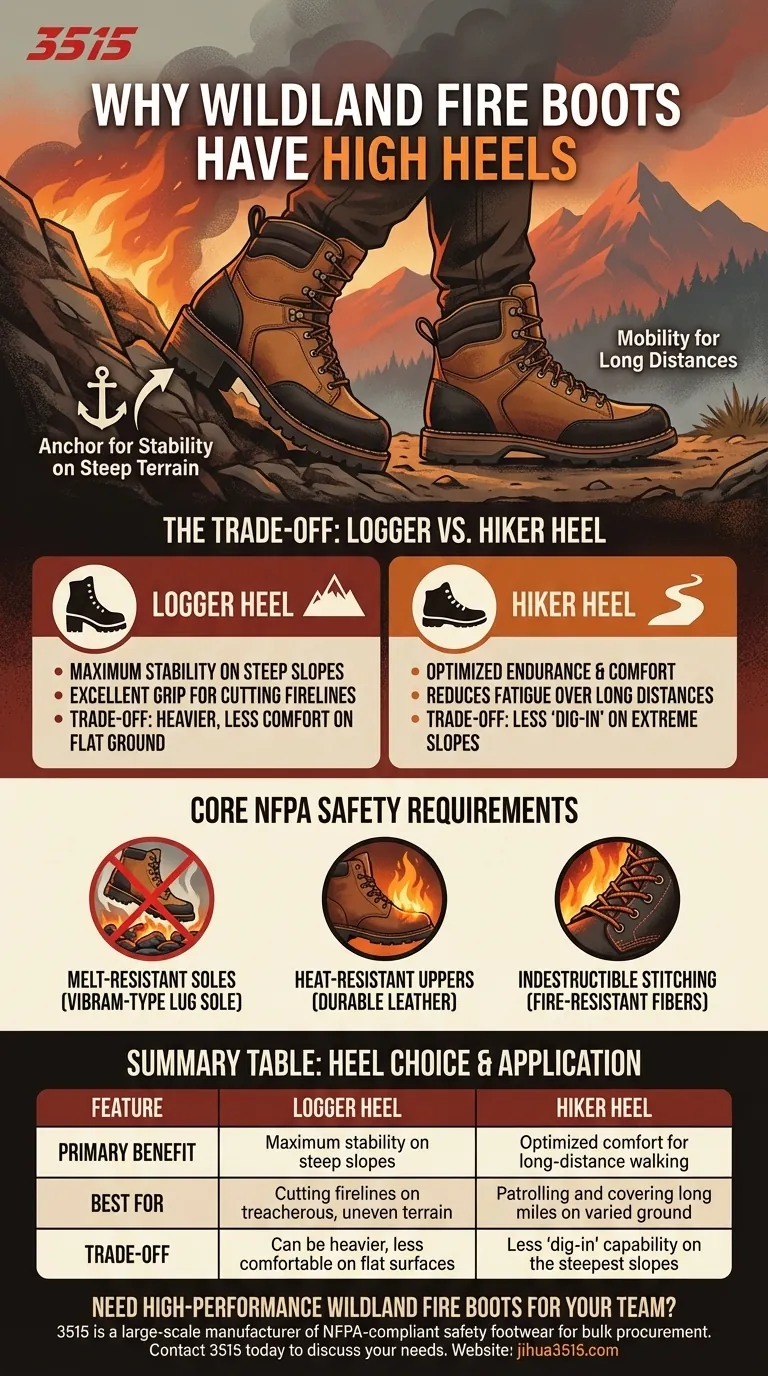
Related Products
- Safety Footwear Wholesale Manufacturer for Custom OEM/ODM Production
- Wholesale Safety Footwear Manufacturer for Bulk & Custom OEM Orders
- Wholesale Customizable Safety Boots Durable & Protective Footwear Manufacturing
- Premium Grain Leather Safety Boots for Bulk Supply
- Heavy Duty Nubuck Safety Boots Safety Shoes for Global Distribution
People Also Ask
- What cultural and environmental considerations are tied to wearing shoes indoors? Balance Hygiene, Tradition, and Foot Health
- How long can you wear safety boots? The Lifespan is Determined by Wear, Not Time
- Is safety-toe as good as steel toe? Choose the Right Protection for Your Job
- What are the differences between steel toe, composite toe, and alloy toe Wellington boots? Choose the Right Safety Toe for Your Job
- Do snake bite boots work? Your Ultimate Guide to Effective Snake Bite Protection



